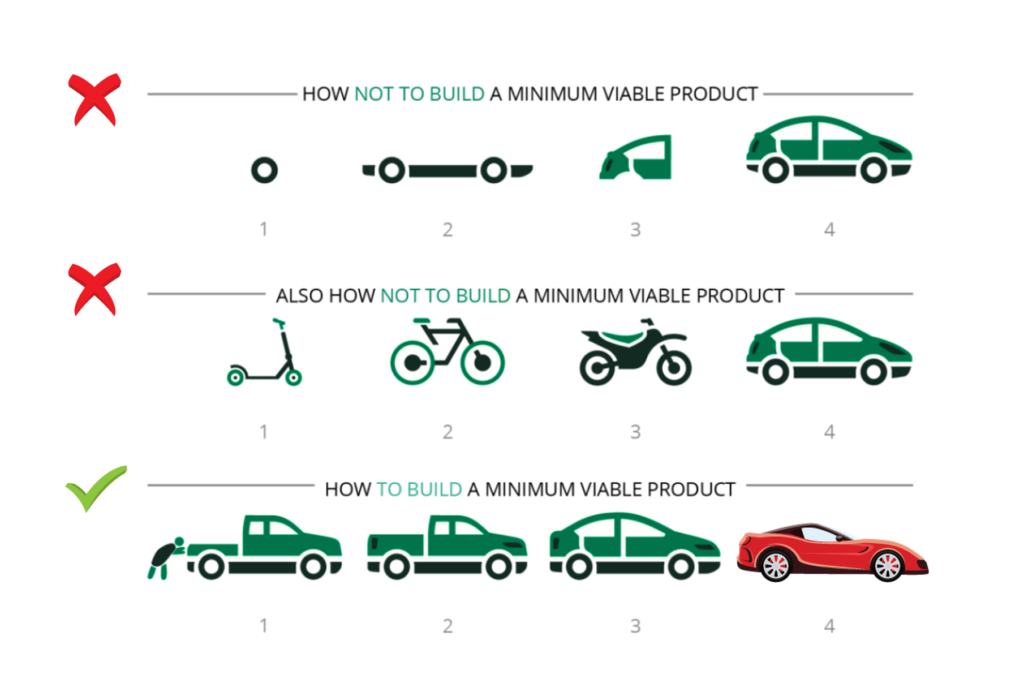Product positioning is the process by which a company brings its product or service to its intended audience. Product positioning acts as the glue that makes your offering stick with customers by effectively communicating your story through your pricing, packaging, differentiators and branding.
If you’ve ever watched a TV commercial, you’ve seen positioning in action. Mercedes-Benz positions its cars differently from Honda. JP Morgan Chase and Bank of America tell different stories to different audiences.
Positioning is a core element of achieving product market fit – along with building a minimum viable product (MVP) and targeting a minimum viable audience (MVA). Positioning a product inadequately can result in missed sales opportunities and wasted development time spent on the wrong features.
You won’t nail your positioning overnight; it’s an iterative process that involves adjusting to customer feedback.
Table of Contents
- What Are the 3 Main Components of Product Positioning?
- Benefits of Product Positioning
- How to Position a Product
- What Is a Product Positioning Statement?
- Product Positioning Examples
What Are the 3 Main Components of Product Positioning?
The three main components of product positioning are:
- Value proposition: What problem does our product solve?
- Target market: Who should buy our product to solve that problem?
- Competitive differentiation: What sets our product apart?
Benefits of Product Positioning
The benefits of product positioning include:
- easier marketing and sales;
- increased product demand;
- reduced customer churn; and
- higher revenue.
Precise positioning is a beautiful thing. The product will be usable and contain the right features for your customers at a reasonable price. Your marketing and sales efforts will be reaching a receptive audience.
Demand for your product will increase. Sales cycles will feel easy, and customers might even seek you out, as opposed to the other way around. Once those customers are onboard, they’ll be less likely to churn because they understood what they were getting into.
All of that is a fancy way to say: Excellent positioning means more revenue for your startup and more opportunities to scale.
How to Position a Product
To position a product successfully, follow these four steps:
- Focus on product enhancements.
- Scale your go-to-market efforts.
- Separate desirability and usability feedback.
- Keep calm and iterate.
1. Focus on Product Enhancements
You know the phrase, “Don’t put the cart before the horse.”? That’s the essence of this first step.
In the early stages — as you build your MVP — it’s important to prioritize product enhancements over go-to-market (GTM) enhancements. Before you hire a massive sales team and spend $1 million on LinkedIn ads, you’ll want to make sure your product is usable and effective. You’ll get this validation by listening to early customers and adapting to their needs.
An MVP isn’t a finished product — and you should never entirely ignore marketing and sales. In simple terms, make sure the engine is running before you go pedal-to-the-metal with your GTM strategy.
2. Scale Your Go-to-Market Efforts
Once you’ve proven that your product meets the needs of a specific customer base, it’s time to amplify your company story. Here’s where you develop a marketing strategy, hire salespeople and, when you’re ready, spend on advertising.
Your marketing collateral, case studies and salespeople will all communicate the product positioning you’ve established.
Don’t go from 0 to 100 too quickly, either. Think of this as continuing to turn up the dial as you gain more validation. For instance, once you validate that an inside sales model can find customers, try a partner channel or add additional advertising on the same target customer profile.
3. Separate Desirability and Usability Feedback
Customer feedback typically comes in two forms: desirability and usability. Desirability includes features and integrations: things customers would like to see. Usability refers to user experience and product quality: things that customers need to use your product.
Prioritize desirability feedback until you find a market segment where your product is resonating. Once you’ve found that target market, prioritize the features that have already achieved product market fit. Rather than building out 10 pretty good features, focus on three excellent features with elite usability.
4. Keep Calm and Iterate
Very few startups find their positioning in one try. You’ll constantly be making small tweaks to the way you communicate your story to the market. Trusted customers will give you feedback, and prospects will share their wish lists of features and integrations.
Don’t pivot based on one or two pieces of feedback. Gather a high volume of information from different sources before you make major changes. Constantly adapt, but do so confidently.
The Path to Product Market Fit
What Is a Product Positioning Statement?
A product positioning statement is a sentence that explains what a product is, what it does and who its customers and competitors are. It’s a guiding document that companies use to bring their products to market and deliver value to customers
To write a positioning statement, follow this formula:
Our product is a [MARKET CATEGORY] that does [UNIQUE ATTRIBUTES], which enables [VALUE] for [TARGET CUSTOMERS], unlike [COMPETITORS].
Product Positioning Examples
To see this formula in action, check out these two product positioning examples:
Tesla’s Cyber Truck
Tesla doesn’t want to position the Cybertruck exactly the same as a GMC, Ford or Chevrolet pickup. It’s supposed to be a sleeker, more innovative, more environmentally friendly option. The company is communicating the following to the market:
Our product is a truck that is both electric and stylish which enables environmentally sustainable performance for upper-middle-class consumers, unlike GMC, Ford and Chevrolet.
Dyn’s Email Delivery Tool
Back when I was working at Dyn with Kyle York, we had to iterate on our positioning. We were selling a tool that helped companies avoid the spam folder and get their marketing emails delivered directly to a customer’s inbox. Here’s how we started with positioning:
Our product is a transactional email delivery service that helps you avoid the spam folder, which enables more ROI on email delivery for every company, unlike traditional ways of sending emails like Simple Mail Transfer Protocol (SMTP) from your own web servers.
Naturally, spammers were interested in this tool. Our sales team was closing deals easily — but with customers that actually delegitimized our offering. We wanted legitimate companies to buy our product, but spammers were muddying the waters.
The Dyn leadership team had to tweak our marketing collateral and re-train our salespeople to avoid unintended audiences. Here’s how we iterated:
Our product is a transactional email delivery service that helps you provide meaningful email content to your target customers, which enables more ROI on email delivery for companies with first-party user signups, unlike traditional ways of sending emails like Simple Mail Transfer Protocol (SMTP) from your own web servers.
See the difference? Avoiding platforms that prioritized third-party user segments through list purchasing or bogus partnerships focused our sales team on finding first-party platforms where users were signing up directly.
Product positioning is an inexact science. Remember that it’s a process. It might take multiple iterations to find the right way to tell your story to the right audience. But it’s worth the time and effort!
Once you’ve successfully positioned your product in the market, your customers and prospects will understand your company’s unique value proposition. They’ll know what to expect when they pay for your services, and your sales and marketing process will get easier. That opens the door for higher revenues and more opportunities to scale — music to any entrepreneur’s ears.
Want to learn more about positioning and how it can help you achieve product market fit? Watch my video on our Fuel platform.







